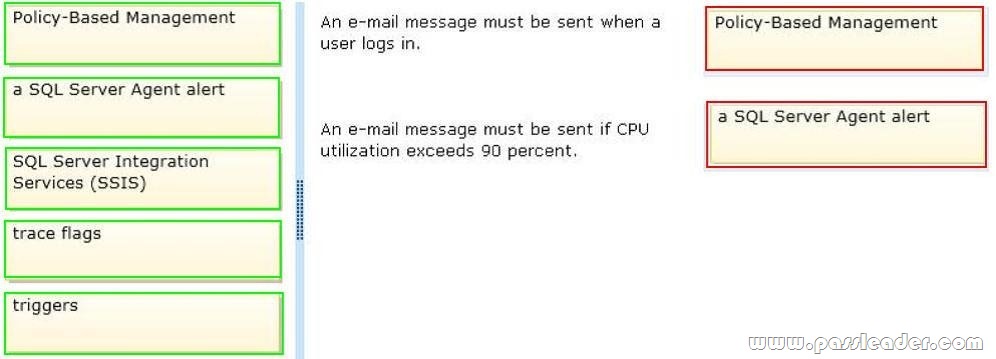Valid 70-465 Dumps shared by PassLeader for Helping Passing 70-465 Exam! PassLeader now offer the newest 70-465 VCE dumps and 70-465 PDF dumps, the PassLeader 70-465 exam questions have been updated and ANSWERS have been corrected, get the newest PassLeader 70-465 dumps with VCE and PDF here: http://www.passleader.com/70-465.html (175 Q&As Dumps)
BTW, DOWNLOAD part of PassLeader 70-465 dumps from Cloud Storage: https://drive.google.com/open?id=0B-ob6L_QjGLpfjFUNFdDRXhFOHFGRTA2N1p5dVYwdW11TFRqTEFCMXdVXzl2ZnR0Y1FBdkk
QUESTION 1
Drag and Drop Question
You need to recommend a backup process for an Online Transaction Processing (OLTP) database. The process must meet the following requirements:
– Ensure that if a hardware failure occurs, you can bring the database online with a minimum amount of data loss.
– Minimize the amount of administrative effort required to restore any lost data.
What should you include in the recommendation? To answer, move the appropriate actions from the list of actions to the answer area and arrange them in the correct order.

QUESTION 2
You use SQL Server 2014 Enterprise Edition. Your database contains a partitioned table named AuditData. AuditData is partitioned by year. Partition 1 contains data from the year 2010 and prior. Management has decided to archive all AUDITDATA records from 2010 and prior. Management wants the records to be removed from the database entirely and provided to the backup team as a zipped text file. The data must no longer reside in the database. There is very little tolerance for performance degradation in your environment. You need to remove all 2010 and prior data from the AuditData table by using the least amount of system resources possible. Develop the solution by selecting and arranging the required SQL actions in the correct order. You may not need all of the actions.

Answer:
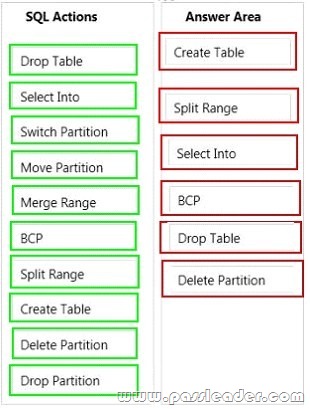
Explanation:
Note:
– Create a new partitioned table with the partition function you want, and then insert the data from the old table into the new table by using an INSERT INTO…SELECT FROM statement.
– SPLIT RANGE (boundary_value). Adds one partition to the partition function. boundary_value determines the range of the new partition, and must differ from the existing boundary ranges of the partition function. Based on boundary_value, the Database Engine splits one of the existing ranges into two. Of these two, the one where the new boundary_value resides is considered the new partition.
– BCP can be used top produce the zipped text file.
QUESTION 3
Drag and Drop Question
You are planning to deploy a database to Windows Azure SQL Database. You need to design a stored procedure to update rows. The stored procedure must meet the following requirements:
– If more than one row is updated, an error must be raised to the application and the update must be discarded.
– The stored procedure must be designed to maximize concurrency.
What should you include in the design? To answer, move the appropriate actions from the list of actions to the answer area and arrange them in the correct order.

QUESTION 4
You are designing a monitoring application for a new SQL Server 2014 instance. You need to recommend a solution to generate a report that displays the 10 most frequent wait types that occur for the instance. What should you include in the recommendation? More than one answer choice may achieve the goal. Select the BEST answer.
A. The SQL Server error log
B. The sys.dm_os_wait_stats dynamic management view
C. The DBCC SQLPERF(WAITSTATS) command
D. SQL Server Profiler
Answer: B
Explanation:
sys.dm_os_wait_stats. Returns information about all the waits encountered by threads that executed. You can use this aggregated view to diagnose performance issues with SQL Server and also with specific queries and batches.
QUESTION 5
Drag and Drop Question
You have two servers named SQL1 and SQL2 that have SQL Server 2012 installed. SQL1 contains a database that is mirrored asynchronously to SQL2. The database contents are updated once a month. You need to upgrade the database to SQL Server 2014. The solution must minimize downtime. Which upgrade steps should you recommend? To answer, move the appropriate actions from the list of actions to the answer area and arrange them in the correct order.
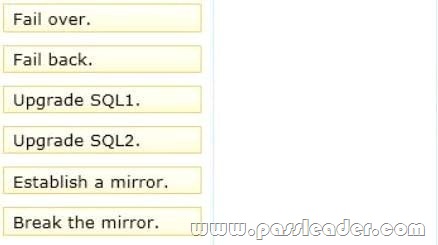
Answer:
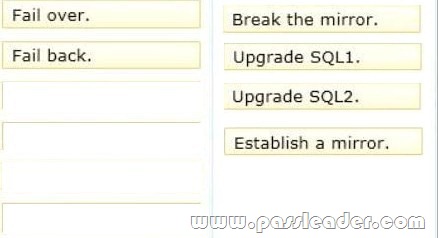
Explanation:
Box 1: Fail over.
Box 2: Upgrade SQL1.
Box 3: Upgrade SQL2.
Box 4: Establish a mirror.
Note:
– To perform the rolling upgrade:
Step 1: For each mirroring session whose mirror server instance has just been upgraded, wait for the session to synchronize. Then, connect to the principal server instance, and manually fail over the session.
Step 2: Upgrade each server instance that is now the mirror server in all mirroring sessions in which it is a partner.
Step 3: Resume the mirroring session.
– When upgrading server instances to SQL Server 2014, you can reduce downtime for each mirrored database to only a single manual failover by performing a sequential upgrade, known as a rolling upgrade. A rolling upgrade is a multi-stage process that in its simplest form involves upgrading the server instance that is currently acting as the mirror server in a mirroring session, then manually failing over the mirrored database, upgrading the former principal server, and resuming mirroring.
Reference: Minimize Downtime for Mirrored Databases When Upgrading Server Instances
QUESTION 6
You deploy a database by using SQL Server 2012. The database contains a table named Table1. You need to recommend a solution that meets the following requirements:
– Stores the most recent data from Table1 by using the fastest storage solution possible.
– Stores the historical data from Table1 by using a slower storage solution.
What should you recommend?
A. partitioned views
B. a database snapshot
C. change data capture
D. table partitioning
Answer: D
QUESTION 7
Drag and Drop Question
You plan to deploy SQL Server 2014. Your company identifies the following monitoring requirements for the database:
– An e-mail message must be sent when a user logs in.
– An e-mail message must be sent if CPU utilization exceeds 90 percent.
You need to identify which feature meets each monitoring requirement. Which features should you identify? To answer, drag the appropriate feature to the correct monitoring requirement in the answer area.

QUESTION 8
You are creating a database that will store usernames and passwords for an application. You need to recommend a solution to store the passwords in the database. What should you recommend? More than one answer choice may achieve the goal. Select the BEST answer.
A. One-way encryption
B. Transparent Data Encryption (TDE)
C. Encrypting File System (EFS)
D. Reversible encryption
Answer: C
Explanation:
– Transparent Data Encryption (TDE) is a special case of encryption using a symmetric key. TDE encrypts an entire database using that symmetric key called the database encryption key. The database encryption key is protected by other keys or certificates which are protected either by the database master key or by an asymmetric key stored in an EKM module.
– SQL Server provides the following mechanisms for encryption:
* Transact-SQL functions
* Asymmetric keys
* Symmetric keys
* Certificates
* Transparent Data Encryption
QUESTION 9
Drag and Drop Question
You have a SQL Azure database named Database1. You need to design the schema for a table named table1. Table1 will have less than one million rows. Table1 will contain the following information for each row:

The solution must minimize the amount of space used to store each row. Which data types should you recommend for each column? To answer, drag the appropriate data type to the correct column in the answer area.

Answer:
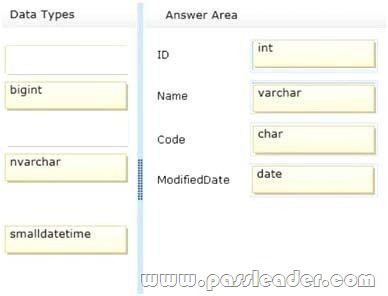
Explanation:
http://msdn.microsoft.com/en-US/library/ms187752.aspx
QUESTION 10
Drag and Drop Question
You need to recommend the actions that are required to partition a table. In which order should the four actions be performed? To answer, move the actions from the list of actions to the answer area and arrange them in the correct order.

Answer:
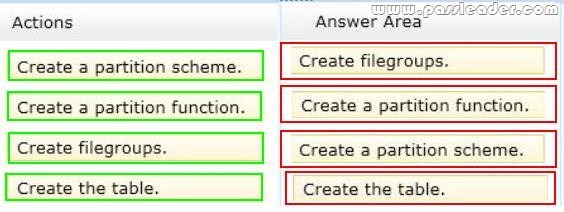
Explanation:
http://technet.microsoft.com/en-us/library/ms188730.aspx
QUESTION 11
You have a SQL Server 2014 environment That contains 20 servers. The corporate security policy states that all SQL Server 2014 instances must meet specific security standards. You need to recommend a management strategy for the SQL Server 2014 servers. What should you include in the recommendation? More than one answer choice may achieve the goal. Select the BEST answer.
A. Multi server jobs
B. Policy-Based Management
C. Common criteria compliance
D. Maintenance plans
Answer: B
Explanation:
Policy-Based Management is a system for managing one or more instances of SQL Server. When SQL Server policy administrators use Policy-Based Management, they use SQL Server Management Studio to create policies to manage entities on the server, such as the instance of SQL Server, databases, or other SQL Server objects.
QUESTION 12
Drag and Drop Question
You are designing a database for a university. The database will contain two tables named Classes and Enrollment that have the following specifications:
– Classes will store brochures in the XPS format. The brochures must be structured in folders and must be accessible by using UNC paths.
– Enrollment will store information about students and their classes. Performance must be enhanced for queries of the current enrollments.
You need to identify which SQL Server technology meets the specifications of each table. Which technologies should you identify? To answer, drag the appropriate technology to the correct table in the answer area.
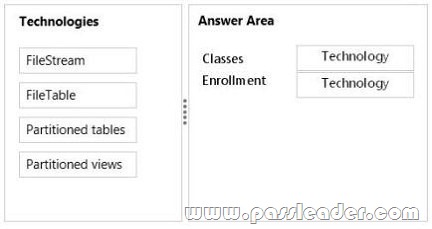
Answer:

Explanation:
The FileTable feature brings support for the Windows file namespace and compatibility with Windows applications to the file data stored in SQL Server. FileTable lets an application integrate its storage and data management components, and provides integrated SQL Server services – including full-text search and semantic search-over unstructured data and metadata. In other words, you can store files and documents in special tables in SQL Server called FileTables, but access them from Windows applications as if they were stored in the file system, without making any changes to your client applications.
QUESTION 13
You deploy a database by using SQL Server 2014. The database contains a table named Table1. You need to recommend a solution to track all of the deletions executed on Table1. The solution must minimize the amount of custom code required. What should you recommend?
A. Change data capture
B. Statistics
C. A trigger
D. Master Data Services
Answer: A
Explanation:
Change data capture is designed to capture insert, update, and delete activity applied to SQL Server tables, and to make the details of the changes available in an easily consumed relational format. The change tables used by change data capture contain columns that mirror the column structure of a tracked source table, along with the metadata needed to understand the changes that have occurred.
QUESTION 14
You have four databases that are accessed by using an Online Transaction Processing (OLTP) application. The databases are stored on a server named SQL1 that has SQL Server 2014 installed. You plan to deploy an additional server that has SQL Server 2014 installed. You need to design a high-availability solution for the databases that meets the following requirements:
– If SQL1 fails, the databases must be available.
– Users must be able to run reports against a secondary copy of the databases.
What should you include in the design? More than one answer choice may achieve the goal. Select the BEST answer.
A. AlwaysOn availability groups
B. Database mirroring
C. Log shipping
D. Failover Clustering
Answer: A
Explanation:
The AlwaysOn Availability Groups feature is a high-availability and disaster-recovery solution that provides an enterprise-level alternative to database mirroring. Introduced in SQL Server 2012, AlwaysOn Availability Groups maximizes the availability of a set of user databases for an enterprise. An availability group supports a failover environment for a discrete set of user databases, known as availability databases, that fail over together.
QUESTION 15
You are troubleshooting an application that runs a query. The application frequently causes deadlocks. You need to identify which transaction causes the deadlock. What should you do? More than one answer choice may achieve the goal. Select the BEST answer.
A. Query the sys.dm_exec_requests dynamic management view.
B. Create a trace in SQL Server Profiler that contains the Deadlock graph event.
C. Query the sys.dm_exec_sessions dynamic management view.
D. Create an extended events session to capture deadlock information.
Answer: D
Explanation:
Troubleshooting deadlocks. You have been receiving reports from users indicating that certain applications are returning deadlock errors. To maximize the effectiveness of troubleshooting these problems, you decide to focus on the deadlocks that are hit most frequently. You create an Extended Events session that:
– Configures deadlock event tracking for the session.
– Specifies a target that aggregates based on an identifier for the deadlock.
You run the Extended Events session, and after additional deadlocks are reported you are able to obtain aggregated deadlock information, along with the complete XML deadlock graph for each source. Using this information you are able to pin point the most common deadlocks and start working on a solution.
Get the newest PassLeader 70-465 VCE dumps here: http://www.passleader.com/70-465.html (175 Q&As Dumps)
And, DOWNLOAD the newest PassLeader 70-465 PDF dumps from Cloud Storage for free: https://drive.google.com/open?id=0B-ob6L_QjGLpfjFUNFdDRXhFOHFGRTA2N1p5dVYwdW11TFRqTEFCMXdVXzl2ZnR0Y1FBdkk


